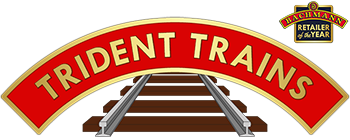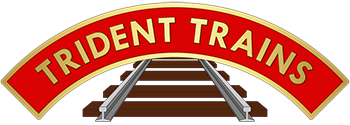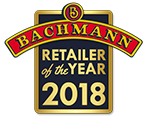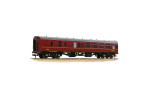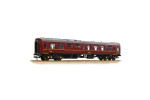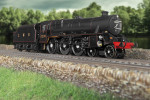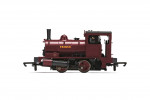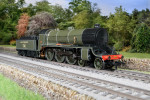Search results
 39-083
39-083BR Mk1 BSK Brake Second Corridor WCRC Maroon
MODEL FEATURES:
Bachmann Branchline OO Scale
Era 9
Pristine West Coast Railway Company Maroon livery
Running No. 99723
Commonwealth Bogies
Accessory Pack
NEM Coupling Pockets
Close Coupling Mechanism
Length 270mm
 39-266
39-266BR Mk1 RMB Restaurant Miniature Buffet WCRC Maroon
MODEL FEATURES:
Bachmann Branchline OO Scale
Era 9
Pristine West Coast Railway Company Maroon livery
Running No. 1860
Commonwealth Bogies
Accessory Pack
NEM Coupling Pockets
Close Coupling Mechanism
Length 270mm
 R30224
R30224LMS, Stanier 5MT 'Black 5', 4-6-0, 5200
The ‘Black 5s', were a mixed traffic locomotive, a ‘do-anything go-anywhere’ type, designed by Stanier and introduced in 1934. In their early days the locomotives were known as the ‘Black Staniers’ because of their black livery, but were later nicknamed ‘Black 5s'. Known for a truly staggering number of potential modifications, the Black 5 was the workhorse of the LMS and later BR from 1934 -1951.
 R30287
R30287United Glass Bottle Manufacturing Ltd, Pug, 0-4-0, No. 19 'Prince'
The diminutive Pug locomotive had its basis in the pre-grouping Lancashire and Yorkshire Railway, with the locomotives being built in batches by their designer John Aspinall, his successor Henry Hoy and his successor George Hughes.
The locomotives were designed as shunters for the northern region. Their small wheels and wheelbase made them ideal to negotiate the tight trackwork that is often found around docks and such. When the grouping act came into effect the locomotives were given the somewhat taunting power classification of 0F, such was their size and the specificity of their use.
Locomotive 19 was built in the 1910 batch, the last such batch of the class built. After its career with the L&YR and then LMS the locomotive was sold to the Mowlem and Co civil engineering company and then to the United Glass Bottle Manufacturers.
There it was bestowed with the name Prince and an attractive marron livery. The locomotive is now preserved, with a fire lit under the boiler in February 2022 being the first since the early 1970s.
 R30273
R30273SR, N15 'King Arthur Class', 4-6-0, 741 'Joyous Gard': Big Four Centenary Collection
The N15 Class, introduced in 1918 from a design by Robert Urie, was also known as the King Arthur Class, being named after persons and places associated with the legend of King Arthur and the Round Table. This class of two cylinder 4-6-0 passenger steam locomotives proved to be one of the most successful during the post-grouping era of 1928-1948, with 74 locomotives being built during this time.
The whole class was built in a total of six batches, with the first two batches being built at the London & South Western Railway's Eastleigh Works between 1918-19 and 1922-23. Carrying the characteristics of Urie's stove pipe chimney, Drummond style of cab and inspired by the shape of the H15, the first batches of locomotives became known as 'Urie Arthurs'.
Upon assuming the position of CME of the Southern Railway, Richard Maunsell built a third batch of ten locomotives at the Eastleigh Works and these became known as the 'Eastleigh Arthurs'. Maunsell's batch incorporated a small number of significant modifications including changes in the draft, valve gear, chimney, blastpipe and an overall increase in boiler pressure that significantly improved the performance.
In 1924 two more batches were ordered from the Scottish based North British Locomotive Company. These 30 locomotives, referred to as 'Scottish Arthurs' were built to the Southern Railways new composite loading gauge and were connected to eight wheel bogie tenders, which had a 5,000 imperial gallon capacity.
The last batch of 15 locomotives were built at Eastleigh between 1926-27 and adopted a six wheel 3,500 imperial gallon tender. Despite the order the batch was never completed, with the last locomotive being replaced by the prototype of the Lord Nelson Class of locomotives. Having proved to be one of the greatest designs of its day, the King Arthur Class combined reliability with impressive performance.
The introduction of electrification, plus the Lord Nelson Class and ultimately, the Bulleid Pacific locomotives, all hastened the N15's departure.'Joyous Gard' was the sixth example of the class to be built, numbered 741 it would leave the shed at Eastleigh in April 1919. During its life the locomotive would receive various modifications such as the class wide installation of smoke deflectors as well as being fitted with a Lemaitre exhaust, becoming one of only five of the class to have the upgrade fitted.
The locomotive would become 30741 under British Railways, before being withdrawn and scrapped in February 1956. Only one member of the class would be preserved, a North British Loco built example, 777 Sir Lamiel, part of the National Collection, under the care of the 5305 Locomotive Association, being based at the Great Central Railway in Leicestershire.
